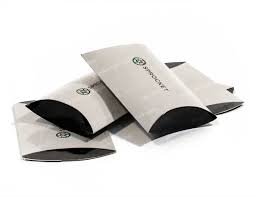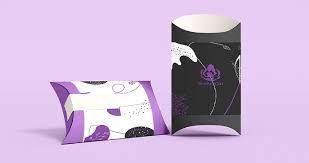Custom Pillow Boxes An Overview
“Discover the versatility and appeal of pillow boxes for packaging. Learn about their benefits, construction, color options, and printing process.”
Pillow Boxes are distinct and attractive packaging options that are often utilized in many sectors to improve the visual attractiveness of goods. These plastic containers got their moniker from the way they stick onto storefronts like pillows.
Benefits of Pillow Boxes
1. Protection:
They provide great protection for tiny and fragile goods. Their robust design guarantees that everything inside is protected throughout travel and storage, reducing the possibility of damage.
2. Appeal to the Eyes:
These containers immediately catch the eye because of their distinctive cushion form. It offers a package solution that is cosmetically appealing and sticks out on store shelves, luring clients while leaving a strong first impression for the company in question.
3. Possibilities for branding:
Large-scale modifications and branding opportunities are provided by Custom Packaging Wholesale. On the boxes, businesses can simply print their logos, product details, and other marketing messages to effectively market their brands and increase brand awareness.
Construction Process of Pillow Boxes
The following stages are part of the building process:
1. Material Selection: For pillow boxes, high-quality materials like cardboard as a base, kraft paper, and rigid cardboard are often used. The desired degree of endurance and sustainability for the environment determine the material choice.
2. Die-Cutting: The substance is die-cut into the intended form of the box using a pre-designed template. These precise and regular cuts made by die-cutting equipment give the boxes an ongoing shape.
3. Scoring and folding: The template is scored and folded after being die-cut. The box may be folded into a pillow form more easily thanks to these lines. To create the correct form, the compartments are then folded onto the scored lines.
4. Applying Glue or Adhesive: Glue or adhesive is put on the proper flaps to fasten the folded box. This guarantees the strength and preservation of the Pillow Packaging.
5. Final touches: After the glue is completely dry, any extra material is cut away, and the container is examined to ensure authenticity. To improve the boxes overall appeal, optional finishing touches may be included, such as handles, ribbons, or custom inserts.
Color Options for Pillow Boxes
Here are some common color options:
1. White: White boxes give a clean and appealing aesthetic. They give an open canvas for putting unique graphics, logos, or brilliant color schemes. White hue denotes pureness, clarity, and refinement.
2. Kraft Brown: Kraft brown cushion boxes offer a natural and organic appearance. These natural colors are commonly selected for sustainable and environmentally conscious solutions for packaging. The brown hue gives a feeling of genuineness, warmth, and environmental conscience.
3. Solid Colors: It may be created in any range of solid hues enabling firms to fit packaging with the branding strategy of the product theme. This includes strong and brilliant hues such red, blue, green, or yellow, in addition to pastel tints including pink, lavender, or mint.
4. Metallic or Foil Colors: Metallic or foil treatments may offer a sense of elegance and glamor to these boxes. Colors like silver, platinum, rose gold, or bronze are widely utilized to create an upmarket and eye-catching package appearance. Metallic coatings usually are linked with elegance, refinement, and high-end items.
5. Patterned or Textured: It may have patterning or textured finishes to enhance visual fascination or distinctiveness. These patterns might include horizontal stripes, polka dots, chevron, damask, or designs with flowers. Rough textures, such as linen, leather, or stamped patterns, offer a tactile sensation and increase the box's total visual appeal.
Printing Process of Pillow Boxes:
1. Design Preparation: The design on the pillow box is made, taking account of branding components, logos, information about the product, and any required visuals or pictures.
2. Color Separation: The picture is divided into different color components for printing. The process guarantees precise shading and enables for the use of different colors or effects.
3. Printing process Selection: The stamping process for these boxes is selected depending on the required output and budget. Common alternatives include printing with digital technology, printing using offsets, or printing on paper.
4. Printing Setup: The printing press or machine is set up with the necessary color inks and plates to fit the design criteria.
5. Printing Execution: They are produced with accurate clear attention to detail, assuring exceptional colors, crisp photographs, and clear words.
6. Drying & Finishing: Once printed, the ink on these boxes is cooled or cured to avoid smudging or spreading. Additional finishing techniques, including varnishing or laminating, might be used for extra protection or aesthetic effects.
7. Quality Control: The printed cartons undergo a strict quality control examination to check for any printing faults or inconsistencies.
8. Packaging and Delivery: The printing boxes are effectively wrapped to prevent any damages during transit. They are then shipped to either customer or package assembly t

